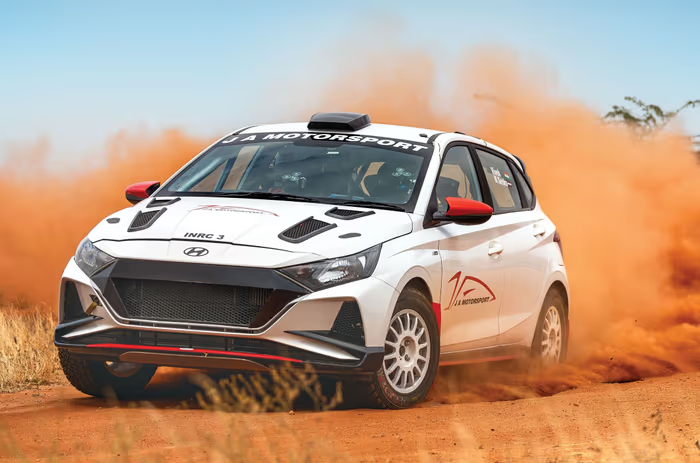The air felt exciting as I sat down in the racing seat of the Hyundai i20 N Line rally car. This wasn’t the normal, sporty small car you see driving around cities. This machine, made ready by JA Motorsport for the Indian National Rally Championship (INRC), was very different – basic, focused, and made for one reason: winning races.
Made for the new INRC 3T class, which allows normal cars with turbo engines smaller than 1400cc, this i20 N Line is very different from the regular version. While the standard N Line gives you a little taste of Hyundai’s fast car division, this rally version has been taken apart and made stronger in all the important places.
The first thing you notice is the inside that’s made for racing. The comfortable features are gone; instead, there’s a simple, useful space with a strong roll cage, tight racing seats with six-point belts, and carbon fiber door panels. The handbrake that uses fluid stands up tall, clearly showing the car is meant to slide. Talking to the person who tells you where to go is very important, helped by a Stilo talking system.
Starting the engine is a big moment. The 1.0-liter turbo gas engine, which you might know, now makes noise through a special exhaust, announcing itself with a louder sound. Changes to the car’s computer and air intake have made it more powerful, giving it a good 140 horsepower and 205 Nm of force. This might not sound like a lot, but in a car that has lost a lot of weight, the power compared to its weight feels much better.
Out on the loose dirt, the i20 N Line rally car immediately feels lively. The button-type ceramic clutch gives a direct and involved connection to the 6-speed manual gearbox. What really changes the driving is the addition of a special kind of gear that helps the wheels grip (limited-slip differential or LSD). The front of the car grabs onto corners very well, letting you turn more sharply and reducing the car sliding straight when you turn (understeer). The grip from the MRF rally tires is amazing, making you feel sure enough to drive harder.
The suspension, with Reiger dampers that can be adjusted in three ways on the better INRC 2 version, is made to handle the bumps of rough rally roads. Even on a fairly smooth test track, the car felt steady and controlled, suggesting it can handle big bumps and jumps.
During a short drive with rally driver Prithveen Rajan, the i20 N Line showed how quick and responsive it is. The car felt like it turned in sharply, reacting quickly to how you moved the steering wheel and letting you put it exactly where you wanted on the track. While I didn’t dare to fully try out the fluid handbrake on my short drive, its presence clearly shows the car’s ability to do controlled slides and tight turns.
The Hyundai i20 N Line rally car is an exciting new competitor in the Indian rally scene. Made by JA Motorsport, a team with a good history in Indian racing, this machine could change things. With prices starting at ₹25 lakh for the INRC 3T version, it’s a good deal for people who want to be rally drivers.
My short time driving it left me with a strong feeling about a car that is basic, fast, and made for a purpose. It shows the focus and engineering needed to change a normal small car into a competitive rally machine. The 2025 INRC season looks like it will be exciting, with the Hyundai i20 N Line ready to show its power on the stages. It might just be the car to bring a new leader in Indian rallying, challenging the cars that have been winning.
